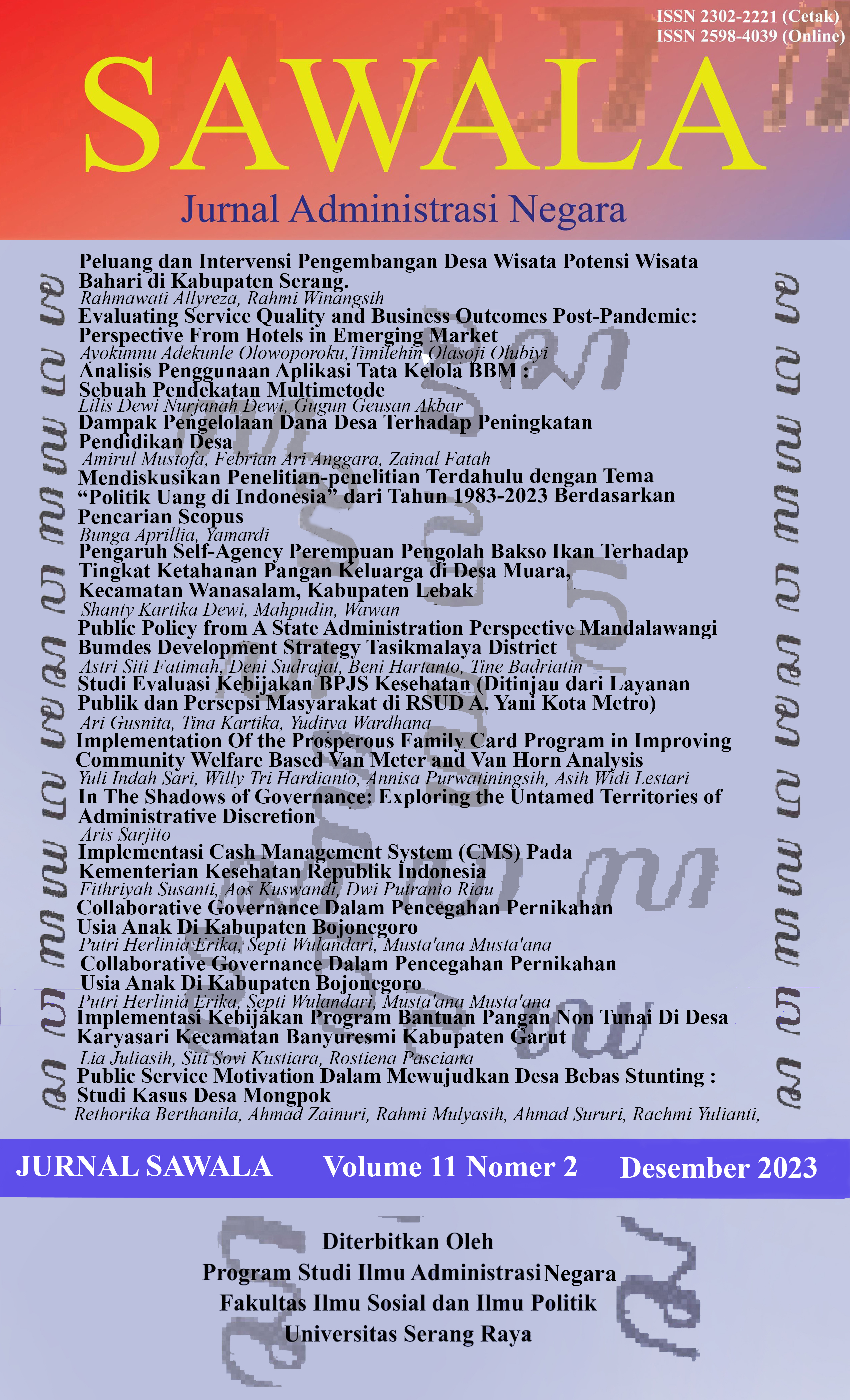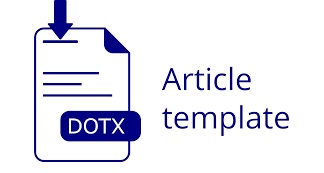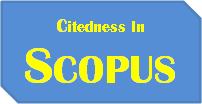In The Shadows of Governance: Exploring the Untamed Territories of Administrative Discretion
DOI:
https://doi.org/10.30656/sawala.v11i2.7754Keywords:
Administrative discretion, Governance, Policy influence, Untamed territoriesAbstract
This research explores administrative discretion's potential in unexplored territories within governance structures, highlighting its impact on public policy and organizational functioning. The primary aim of this study is to comprehensively understand and map these untamed territories, offering insights into their identification and implications for governance effectiveness. Qualitative research methods are employed, thoroughly analyzing secondary data sources, including academic literature, government reports, and case studies. Through this method, the study explores the multifaceted dimensions of administrative discretion, identifies the uncharted territories where it operates, and assesses its implications on the overall effectiveness of governance structures. Research findings are: Legal, political, and organizational factors all impact the multifaceted concept of administrative discretion in public administration. This concept is crucial for effective and accountable governance, using theoretical frameworks like principal-agent theory. Identifying and mapping untamed territories in governance involves a multi-faceted approach, requiring document analysis, stakeholder consultations, and expert interviews to develop responsive governance structures. Assessing the impact of untamed territories on governance effectiveness is crucial for responsiveness to evolving challenges. Traditional models need a paradigm shift, embracing innovation, collaboration, and adaptability to navigate complexities
References
Aberbach, J. D., Putnam, R. D., & Rockman, B. A. (1981). Bureaucrats and politicians in Western democracies. Harvard University Press.
Andersson, K. (2021). What Is It, and What Is It Good For? International Food Policy Research Institute. http://www.jstor.org/stable/resrep46757
Ansell, C., & Gash, A. (2008). Collaborative Governance in Theory And Practice. Journal of Public Administration Research and Theory, 18(4), 543–571.
Baldwin, R. (2019). Better Regulation for Innovation. Centre for Economic Policy Research.
Baldwin, R., Cave, M., & Lodge, M. (2011). Understanding Regulation 2E P: Theory, Strategy, and Practice. Oxford University Press.
Ballard, C., Baldwin, J., Baryudin, A., Brunell, G., Giardina, C., Haber, M., O’neill, E. A., & Shah, S. (2014). IBM information governance solutions. IBM Redbooks.
Bardach, E. (1977). The Implementation Game: What Happens After a Bill Becomes A Law.
Bevir, M. (2012). Governance: A very short introduction. OUP Oxford.
Biermann, F., Pattberg, P., Van Asselt, H., & Zelli, F. (2009). The fragmentation of global governance architectures: A framework for analysis. Global Environmental Politics, 9(4), 14–40.
Boote, D. N., & Beile, P. (2005). Scholars before researchers: On the Centrality of The Dissertation Literature Review In Research Preparation. Educational Researcher, 34(6), 3–15.
Bovens, M. (2007). Analysing and Assessing Accountability: A Conceptual Framework 1. European Law Journal, 13(4), 447–468.
Bowen, G. A. (2009). Document Analysis as A Qualitative Research Method. Qualitative Research Journal, 9(2), 27–40.
Braun, V., & Clarke, V. (2006). Using Thematic Analysis in Psychology. Qualitative Research in Psychology, 3(2), 77–101.
Chaffin, B. C., Gosnell, H., & Cosens, B. A. (2014). A Decade of Adaptive Governance Scholarship: Synthesis and Future Directions. Ecology and Society, 19(3).
Christensen, R. K., Goerdel, H. T., & Nicholson-Crotty, S. (2011). Management, Law, And The Pursuit Of The Public Good In Public Administration. Journal of Public Administration Research and Theory, 21(suppl_1), i125–i140.
Cooper, H., Hedges, L. V, & Valentine, J. C. (2019). The Handbooko of Research Synthesis and Meta-Analysis. Russell Sage Foundation.
Craig, R. K., Garmestani, A. S., Allen, C. R., Arnold, C. A. (Tony), Birgé, H., DeCaro, D. A., Fremier, A. K., Gosnell, H., & Schlager, E. (2017). an Analysis of Tools Available in U.S. environmental law. Ecology and Society, 22(2). http://www.jstor.org/stable/26270068
Creswell, J. W., & Creswell, J. D. (2017). Research design: Qualitative, Quantitative, and Mixed Methods Approaches. Sage publications.
DiMaggio, P. J., & Powell, W. W. (2012). The Iron Cage Revisited: Institutional Isomorphism and Collective Rationality in Organizational Fields [1983]. Contemporary Sociological Theory, 175.
Eisenhardt, K. M. (1989). Agency theory: An Assessment and Review. Academy of Management Review, 14(1), 57–74.
Emerson, K., Nabatchi, T., & Balogh, S. (2012). An Integrative Framework for Collaborative Governance. Journal of Public Administration Research and Theory, 22(1), 1–29.
Ferlie, E., Fitzgerald, L., McGivern, G., Dopson, S., & Bennett, C. (2013). Making Wicked Problems Governable? The case of managed networks in health care. OUP Oxford.
Folke, C., Hahn, T., Olsson, P., & Norberg, J. (2005). Adaptive governance of social-ecological systems. Annu. Rev. Environ. Resour., 30, 441–473.
Fraussen, B., Albareda, A., & Braun, C. (2020). Conceptualizing consultation approaches: identifying combinations of consultation tools and analyzing their implications for stakeholder diversity. Policy Sciences, 53, 473–493.
Fung, A. (2009). Empowered participation: Reinventing urban democracy. Princeton University Press.
Gustafsson, M.-T., & Schilling-Vacaflor, A. (2022). Indigenous Peoples and multiscalar environmental governance: The opening and closure of participatory spaces. Global Environmental Politics, 22(2), 70–94.
Hofstede, G. (1984). Culture’s consequences: International differences in work-related values (Vol. 5). sage.
Kaplan, A. M., & Haenlein, M. (2016). Higher education and the digital revolution: About MOOCs, SPOCs, social media, and the Cookie Monster. Business Horizons, 59(4), 441–450.
Kettl, D. F. (2000). The transformation of governance: Globalization, devolution, and the role of government. Public Administration Review, 60(6), 488–497.
Klijn, E.-H., & Koppenjan, J. F. M. (2000). Public management and policy networks: foundations of a network approach to governance. Public Management an International Journal of Research and Theory, 2(2), 135–158.
Klimczuk, A., Shamsudin, F. M., Sukmawati, A., Fernandes, P., Pereira, R., & Wiedenhöft, G. (2023). Open Access Edited by Organizational culture and the individuals’ discretionary behaviors at work: a cross-cultural analysis. https://doi.org/10.3389/fsoc.2023.1190488
Kooiman, J. (1993). Modern Governance: New Government-Society Interactions. Modern Governance, 1–288.
Krippendorff, K. (2018). Content analysis: An introduction to its methodology. Sage publications.
Lapuente, V. (2020). Politicization, Bureaucratic Legalism, and Innovative Attitudes in the Public Sector. https://doi.org/10.1111/puar.13175
Macgilchrist, F., Allert, H., & Bruch, A. (2020). Students and Society in the 2020s. Three Future ‘Histories’ of Education and Technology. Learning, Media and Technology, 45(1), 76–89.
Meier, K. J., & Bohte, J. (2001). Structure and Agency in Environmental Policy Implementation: Forest Service Responses to The Spotted Owl. Journal of Public Administration Research and Theory, 11(2), 119–144.
Miles, M. B., Huberman, A. M., & Saldaña, J. (2014). Qualitative Data Analysis: A Methods sourcebook. Sage Publications.
Osborne, S. P. (2010). The new public governance? Emerging perspectives on the theory and practice of public governance. Routledge.
Ostrom, E. (2005). Understanding Institutional Diversity. Princeton University Press.
Ostrom, E. (2009). A General Framework for Analyzing Sustainability of Social-Ecological Systems. Science, 325(5939), 419–422.
Pierre, J., & Peters, B. G. (2020). Governance, Politics and the State. Bloomsbury Publishing.
Rhodes, R. A. W., & Osborne, S. (2002). The new governance: governing without government. S. Osborne (Ed), Public Management: Critical Perspectives, 208–226.
Rosenbloom, D. H., Kravchuk, R. S., & Clerkin, R. M. (2022). Public Administration: Understanding Management, politics, and law in the public sector. Routledge.
Seale, C. (2002). Quality Issues in Qualitative Inquiry. Qualitative Social Work, 1(1), 97–110.
Teece, D. J. (2007). Explicating dynamic capabilities: the nature and microfoundations of (sustainable) enterprise performance. Strategic Management Journal, 28(13), 1319–1350.
Turner, R. B. (2017). The Role of Administrative Discretion in Policy Implementation. Public Policy Studies, 25(3), 321–340.
Yin, R. K. (2009). Case Study Research: Design and Methods (Vol. 5). Sage.









